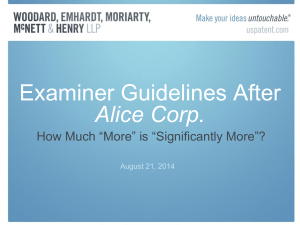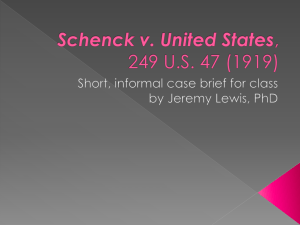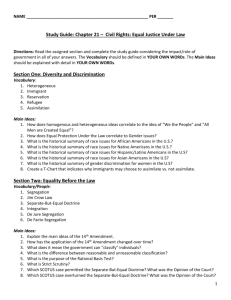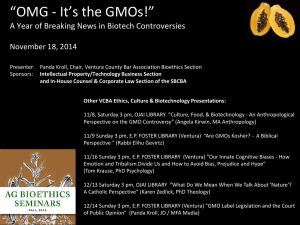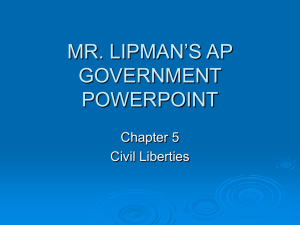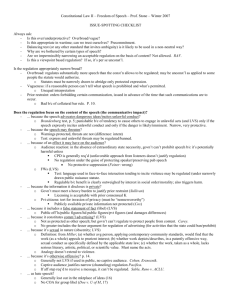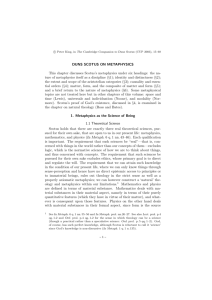Word
advertisement
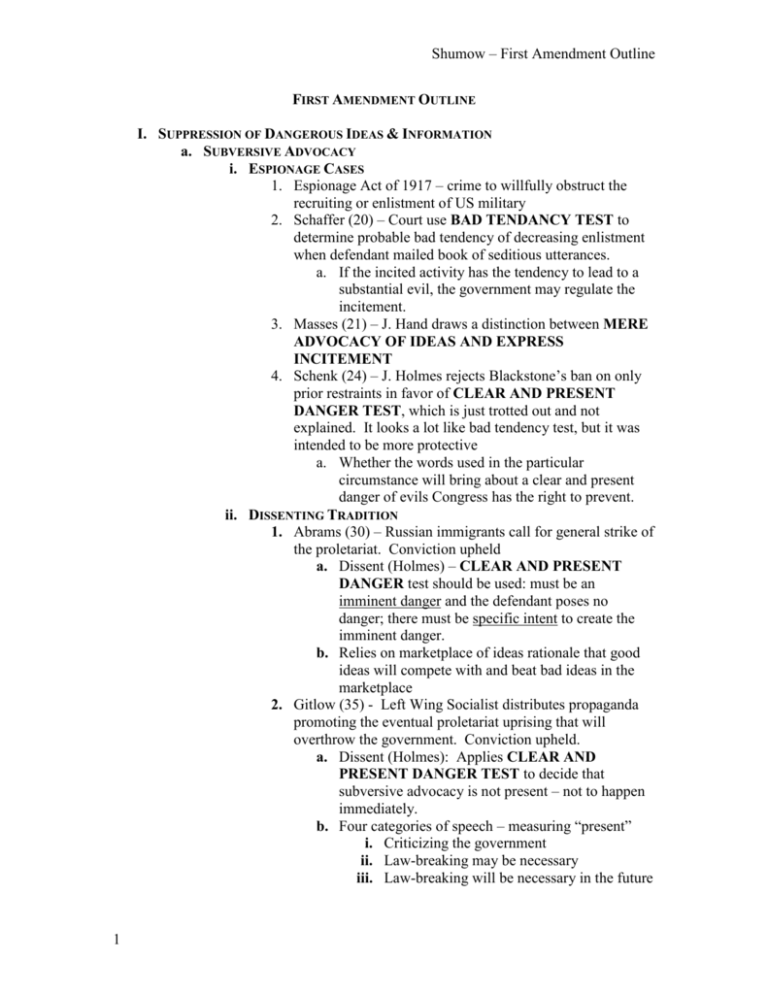
Shumow – First Amendment Outline FIRST AMENDMENT OUTLINE I. SUPPRESSION OF DANGEROUS IDEAS & INFORMATION a. SUBVERSIVE ADVOCACY i. ESPIONAGE CASES 1. Espionage Act of 1917 – crime to willfully obstruct the recruiting or enlistment of US military 2. Schaffer (20) – Court use BAD TENDANCY TEST to determine probable bad tendency of decreasing enlistment when defendant mailed book of seditious utterances. a. If the incited activity has the tendency to lead to a substantial evil, the government may regulate the incitement. 3. Masses (21) – J. Hand draws a distinction between MERE ADVOCACY OF IDEAS AND EXPRESS INCITEMENT 4. Schenk (24) – J. Holmes rejects Blackstone’s ban on only prior restraints in favor of CLEAR AND PRESENT DANGER TEST, which is just trotted out and not explained. It looks a lot like bad tendency test, but it was intended to be more protective a. Whether the words used in the particular circumstance will bring about a clear and present danger of evils Congress has the right to prevent. ii. DISSENTING TRADITION 1. Abrams (30) – Russian immigrants call for general strike of the proletariat. Conviction upheld a. Dissent (Holmes) – CLEAR AND PRESENT DANGER test should be used: must be an imminent danger and the defendant poses no danger; there must be specific intent to create the imminent danger. b. Relies on marketplace of ideas rationale that good ideas will compete with and beat bad ideas in the marketplace 2. Gitlow (35) - Left Wing Socialist distributes propaganda promoting the eventual proletariat uprising that will overthrow the government. Conviction upheld. a. Dissent (Holmes): Applies CLEAR AND PRESENT DANGER TEST to decide that subversive advocacy is not present – not to happen immediately. b. Four categories of speech – measuring “present” i. Criticizing the government ii. Law-breaking may be necessary iii. Law-breaking will be necessary in the future 1 Shumow – First Amendment Outline iv. Law-breaking necessary NOW c. Gitlow is #3 and should be allowed; only #4 should be barred. 3. Whitney (41) – Moderate Socialist convicted for extreme wing’s call for uprising. Court held it was not arbitrary use of police power to convict her. a. Concurring (Brandeis) – Applies CLEAR AND PRESENT DANGER TEST to hold that she should be convicted. i. Clear – incitement cannot be punished unless the resulting harm is serious ii. Present – express advocacy cannot be punished unless it rises to the level of incitement (category 4 – call to arms now) iii. Rationale for free speech – self-governance 1. Holmes: marketplace/search for truth iv. Deference – court shouldn’t defer to economic rights and not defer to fundamental rights – anti-Lochner iii. FIRST AMENDMENT AS A PREFERENTIAL RIGHT 1. As political rights gained power, capitalism lost power a. Carolene Products, footnote 4 – end of Lochner-like deference on economic issues where none existed for “fundamental rights” 2. SCOTUS invalidated three subversive advocacy convictions on technical grounds between 1927-1937 a. Shows that the court is willing to take a close look at the factual record b. Ensures due process rights for alleged criminals c. First Amendment (and selected other rights) are tied to democracy – people have a PREFERENTIAL RIGHT in the First Amendment iv. MODERN SUBVERSIVE ADVOCACY – BLACK LETTER LAW 1. Dennis (48) – Leaders of the Communist Party are convicted of violating the Smith Act (subversive advocacy) when they promoted the eventual overthrow of government. Court upholds conviction under WATEREDDOWN CLEAR & PRESENT DANGER TEST. a. Learned Hand’s formulation adopted: The gravity of evil less its improbability must be greater than the harm caused by invasion of free speech i. No need to wait until overthrow occurs to censor the activity; still “imminent” ii. Highly deferential to Congress 2 Shumow – First Amendment Outline b. Douglas’ dissent: Should have considered the case on evidentiary grounds, because the overthrow of the US Government was NOT imminent! i. Commies are “miserable merchants of unwanted ideas” – marketplace of ideas ii. Free speech is what defeats Communism – similar to the Brandeis Concurrence in Whitney c. Different from Holmes-Brandeis Clear & Present Danger Test i. More deferential 1. Frankfurter concurrence – defer to Congressional findings on dangers of Communism ii. No imminence 2. Brandenburg (59) – Leader of KKK convicted for his message that white separatists will have their “revengence” on US Government for embracing Blacks and Jews. Per curiam opinion holds that the conviction was wrong. NEW TEST: Subversive advocacy must be directed to inciting or producing imminent lawless activity that is likely to produce such action a. Black: Clear & present danger is dead – Dennis only cited in showing that Gitlow & Whitney are overturned b. Douglas: Clear & present danger is dead because its Dennis version was (1) too malleable and (2) overregulated speech Subversive Advocacy – four tests 1. Bad tendency - If the incited activity has the tendency to lead to a substantial evil, the government may regulate the incitement. 2. Holmes-Brandeis Clear & Present Danger – must be serious (clear) and imminent (present) danger to regulate the advocacy of speech CATEGORY FOUR SPEECH ONLY 3. Dennis Clear & Present Danger – The gravity of the harm, discounted by its improbability, must be greater than the harm of invading speech ADOPTS L. HAND’S FORMULATION 4. Brandenburg – Must be (1) express advocacy of violation of the law, (2) that calls for immediate action, and (3) is likely to occur. SERIOUSNESS IGNORED, but maybe under factor 1 3 Shumow – First Amendment Outline b. THREATS & PROVOCATION i. THREATS 1. Bridges (66) – Two cases: (1) Union president threatened to cripple the West Coast with a strike if the Secretary of Labor enforced a new law and (2) LA Times Editorial said it would be a big mistake for elected judges to let off two “union goons.” a. Convictions overturned under CLEAR AND PRESENT DANGER TEST – i. The substantive evil must be EXTREMELY SERIOUS and the degree of IMMINENCE EXTREMELY HIGH before utterances are punishable 2. Watts (69) – Potential draftee not convicted for saying, if drafted, he would go after LBJ. Speech is only a hyperbole if clear & present danger test is satisfied. Here, speech was not likely nor imminent (neither clear nor present). ii. PROVOCATION 1. Cantwell (Supp. 3) – Jehovah’s Witness was convicted for selling material on Cassius Street without a license and for disturbing the peace by playing Judge Rutherford’s records. SCOTUS overturned the conviction, because the regulation was OVERBROAD! a. Speech is too important to hinge on a bureaucrat’s ability to arbitrarily regulate speech via a license i. Requiring a license sounds like a prior restraint 2. Feiner (76) – Man was convicted for breach of peace during a protest. Conviction upheld under CLEAR AND PRESENT DANGER TEST. a. Watered-down version of test: when clear and present danger of immediate threat to public safety appears, the State may regulate or prevent the speech. b. Dissent: If a police officer is silencing speech, it is the police officer who is violating the law, not the speaker. Threats – clear & present danger test Threat: An individual (1) intends to communicate a serious expression of a threat (2) to commit an unlawful act of violence (3) to a particular individual or group of individuals True threats: unprotected Some threats are protected - The substantive evil must be (1) extremely dangerous and (2) the degree of imminence must be extremely high before the utterances are punishable. 4 Shumow – First Amendment Outline Provocation Clear and present danger test: when clear and present danger of immediate threat to public safety appears, the State may regulate or prevent the speech But that was laid out before Brandenburg factors changed the test. iii. FIGHTING WORDS 1. Chaplinksy (83) – Jehovah’s Witness convicted for calling a cop a “goddamned racketeer” under a statute (so construed by the state courts) to disallow only face-to-face fighting words. a. TEST: Government may regulate words that men of common intelligence would understand to be words likely to cause an average addressee to fight. i. Subjective (thus narrower protection) ii. Categorical b. Fighting words defined: words that (1) inflict injury and (2) incite an immediate breach of peace merely by their utterance 2. Gooding (87) – Statute is overbroad on its face, because state court didn’t limit statute to only face-to-face fighting words. 3. No conviction upheld under fighting words since Chaplinsky. 4. Philosophy a. Posner – lots of conventional ideas today were once radical b. Alternate: some speech just shouldn’t be protected if it neither adds to process of self-government nor adds to the search for truth c. CONFIDENTIAL INFORMATION i. NATIONAL SECURITY (Pentagon Papers) 1. Court refused to grant injunction on NYTimes and WAPost to prevent them from publishing information about Vietnam War, because Executive Branch could outlaw the activity in a more narrow way by outlawing the leaking of information. 2. In order to grant an injunction, it must be the most narrow solution possible. ii. PRIVACY (Cox) 5 Shumow – First Amendment Outline 1. Newspaper identified a rape victim based on information learned in court proceedings. Court refused to prevent or punish information lawfully obtained and newsworthy. iii. DUE PROCESS (Nebraska Press) 1. Court refused to allow gag order on NE paper to stand, because (1) prior restraints are disfavored and (2) less restrictive alternate means exist to prevent leak of information about multiple murders in NE. iv. JUDICIAL ADMINISTRATION (Landmark) 1. Court refused to punish the press that leaked information about the state ethics board’s review of “crooked” judges, because (1) it’s a matter of public concern and (2) it’s important for people to know whether elected or appointed judges are corrupt. v. DANGEROUS TECHNICAL INFORMATION (Progressive) 1. Press allowed to publish instructions on how to make an Hbomb on technicalities. FACIAL CHALLENGES – OVERBREADTH, VAGUENESS, & PRIOR RESTRAINT II. PRIOR RESTRAINT a. LICENSING i. Lovell (125) – City statute gave the mayor the decision whether to allow distribution of literature on city streets. The SCOTUS invalidated a conviction of Jehovah Witnesses under that statute, because the statute was overbroad. 1. Licensing is only allowed if there are (1) clear standards by which to qualify for the license and (2) procedural safeguards. b. INJUNCTION i. Near (131) – MN statute allowed injunction against “malicious, scandalous, or defamatory” publications. The SCOTUS invalidated the statute, calling it “the essence of censorship.” 1. Content-based prior restraints are highly disfavored. c. PROBLEMS WITH PRIOR RESTRAINT i. Ideas don’t get out 1. Only rationale present in Near ii. Censorship is over-inclusive iii. There’s a lack of standards 1. Problem in Lovell iv. A censor is more likely to want to censor v. There’s an absence procedural safeguards 1. Problem in Lovell III. OVERBREADTH a. Gooding (113) – GA statute prohibits saying any “abusive words” to other people. A war protester is convicted for telling a police officer that he 6 Shumow – First Amendment Outline would cut the officer to pieces. SCOTUS invalidated the conviction, because it was too broad – can’t cover ALL abusive language. i. Similar statute to Chaplinsky, except that statute was construed narrowly by the state courts to cover only fighting words. b. Definition: accessing constitutionality of a statute by examining the various forms of speech regulated by the face of the statute regardless of the criminal’s guilt or innocence c. Rationale for an Overbreadth Defense i. First Amendment is so important that the court can root out constitutional defects in laws ii. The government AND THE ACCUSED needs to protect third parties possibly chilled by the invalid statute d. Criticisms i. Ignores case & controversy clause ii. Let’s guilty go free iii. Little guidance to legislators IV. VAGUENESS a. Persons of common intelligence must be able to know what is punishable under the law before they are punished Statutes that facially regulate speech must be drawn with precision NO PRIOR RESTRAINTS – either in licensing (Lovell) or injunction (Near) NOT OVERBROAD – can’t regulate too much speech (Gooding) NOT VAGUE – can’t regulate without clear language that allows regulation V. CONTENT-BASED LOW VALUE SPEECH a. DEFAMATION i. FORMS OF DEFAMATION 1. Libel – written 2. Slander - spoken ii. PUBLIC FIGURES 1. New York Times v. Sullivan (140) – Elected AL Police Commissioner alleged libel for advertising in the NY Times based on false statements of facts regarding civil rights violations by “police” under his supervision (though he is not mentioned by name). SCOTUS reversed judgment, holding THERE MUST BE ACTUAL MALICE TO SUSTAIN LIBEL AGAINST A PUBLIC OFFICIAL/FIGURE. a. Actual malice manifested either i. Knowingly false ii. Reckless regard for the truth of the matter asserted b. Actual malice is underprotective i. There is an absolute right to speak 7 Shumow – First Amendment Outline ii. Any ability to curb speech chills robust, wide-open speech rights c. Actual malice is overprotective i. SCOTUS undervalues reputation ii. Maybe chilling false statements isn’t bad! iii. Might drive sensitive people out of politics iv. Cheapens the First Amendment to extend Actual Malice too far d. Applies to public “figures” as well – GA Athletic Director (Butts) could not claim libel to reputation when he was accused of rigging a game between GA and AL unless there is ACTUAL MALICE. 2. Two types of public figures a. All-purpose b. Limited purpose 3. Officials as public figures a. “Major” officials are b. “Minor” officials are not i. but this distinction isn’t very helpful in linedrawing iii. PRIVATE FIGURES 1. Gertz (151) – Publisher accused Gertz of setting up a murder for which he later defended the family. SCOTUS held that NYTimes actual malice does not control, because Gertz is not a public figure. But ACTUAL MALICE IS REQUIRED FOR PUNITIVE DAMAGES. a. Each state may create its own standard for defamation, but it must be a lower standard than NYTimes’ actual malice. b. Public figures and public officials have greater access to channels of communication, so they can combat false statements more easily. c. Public figures & officials assume the risk of some defamation by taking their role in society. 2. Dun & Bradstreet (158) – Plurality of the court decided that private figures defamed on matters of private concern need not show actual malice for punitive or compensatory damages. Public official/figure is defamed Private person is defamed 8 Matter of PUBLIC CONCERN Actual Malice (New York Times v. Sullivan) (Limited purpose public figure?) Not a matter of public concern (no private life for public figures) Less Than Actual Malice (Dun & Bradstreet) – less than actual malice for both Shumow – First Amendment Outline punitive & compensatory damages Gertz – less than Actual Malice for private individuals (except for punitive damages) For Defamation, three questions: 1) Is it a public official or figure or is it a private individual? (NYTimes v. Sullivan) 2) If it is a private individual, is the speech on a matter of public concern? (Dun & Bradstreet) 3) If it is a private individual and the speech is a matter of public concern, are the requested damages compensatory or punitive? (Gertz, as limited by Dun & Bradstreet’s plurality by Powell, Rehnquist & O’Connor, concurred by White & Burger who want to wholly overrule Gertz) b. COMMERCIAL SPEECH i. Virginia Pharmacy (169) – SCOTUS invalidated a VA statute that barred disseminating information about prescription drug prices, out of fear of the effect on the market. SCOTUS held that commercial speech is protected under the First Amendment unless it is false or misleading. (CONTENT-BASED) 1. Blackmun’s new First Amendment rationale: Free Flow of Information to Sustain an Efficient Market a. Different than search for truth or self-governance b. Rehnquist dissents based on the novel rationale ii. Central Hudson (180) – Utility commission allowed utility to engage in commercial speech where advertising is informational rather than promotional. SCOTUS invalidated regulation, because it fails new intermediate scrutiny test: 1. Commercial speech must be lawful, not misleading 2. Government must have a substantial interest in regulating activity 3. Regulation must directly advance government purpose 4. Regulation must be no more restrictive than necessary a. Sunni v. Fox: tailoring prong (#4) doesn’t require least restrictive means but only a “reasonable fit” b. Posadas (182) – PR legalized gambling, but made it illegal to advertise gambling. Rehnquist used “greater includes the lesser” rationale, noting that PR can prohibit gambling, so they can also prohibit advertising. c. 44 Liquormart (184) – Rejects Posadas “greater includes the lesser” argument. d. Lorillard (185) – MA statute prohibits advertising within 1000 feet of public playground. SCOTUS: the regulation is too geographically broad. e. Thompson (187) – SCOTUS invalidated Congress’ ban on advertising for compounding drugs, because 9 Shumow – First Amendment Outline there are available ways to ban large-scale compounding and protecting speech. iii. Central Hudson intermediate scrutiny test is lower standard than Virginia Pharmacy, which barred regulation on ANY lawful, nonmisleading advertisements (per Blackmun) 1. Close to strict scrutiny and thus very protected Intermediate Scrutiny under Central Hudson: 1. Commercial speech must be lawful, not misleading 2. Government must have a substantial government interest in regulating the speech. 3. The regulation must directly advance the government interest. 4. The regulation must be a “reasonable fit” (SUNNI) Regulations tend to fail on this ground, despite Sunni’s deference (LORILLARD) c. OBSCENITY i. GENERALLY 1. DEFINITIONAL a. Roth (198) – SCOTUS affirmed conviction of man who mailed a publication with erotic literature inside, because the publication taken as a whole appeals to the prurient interests of the average person, under community standards. b. Memoirs – Obscene material (1) has a dominant theme as a whole that appeals to the prurient interests (2) is patently offensive the community, and (3) with “utterly without redeeming social value” c. Stanley – you can watch porn when you’re alone in your own living room d. Miller (206) – SCOTUS reversed conviction for Miller who sent unsolicited ads of illustrated sex acts. i. Whether the material as a whole appeals to the prurient interest of the average person, considering community standards 1. Must be turned on 2. Local, subjective standard ii. Whether the work depicts sexual conduct in a patently offensive way 1. Must be grossed out 2. Local subjective standard iii. Taken as a whole, the work lacks serious literary, artistic, political, or scientific value 1. National, objective standard 10 Shumow – First Amendment Outline e. Paris Adult Theatre (209) – SCOTUS held there’s a substantial government interest in stemming the tide which has an “arguable correlation” to the government interest of stemming the tide of commercialized obscenity. 2. SUPPRESSIVE a. Now that “obscenity” is defined in Miller, the question is how much suppression of obscenity is allowed. ii. CHILD PORN 1. Ferber (218) – Adult bookstore sold videos of boys masturbating. Court categorically excluded child porn from Miller Test. Instead, no child porn allowed – unless actor is young-looking adult or made of clay or something like that. a. Sale makes it more likely that children will be used in child porn. b. Child porn is abusive to children. c. Prosecuting possession of child porn will dry up the market. 2. Free Speech Coalition (221) – Congress outlawed having of-age actors who look younger, but the SCOTUS invalidated the law because it went beyond Ferber. a. No harm to children under these facts. b. Erotic themes with children is motif in literature – Romeo & Juliet. d. INDECENT SPEECH i. GENERALLY 1. Cohen (225) – Cohen convicted for disturbing the peace with offensive conduct when he only wore a jacket that said “Fuck the Draft” inside a courthouse in protest of the Vietnam War. SCOTUS denied the conviction, relying on self-governance rationale. a. Not libel, fighting words, hostile audience/incitement, obscenity b. Captive audience – people are trapped and cannot leave, such that your freedom of speech infringes on their privacy i. Here, people can simple “avert their eyes” – no captive audience problem c. “One man’s vulgarity is another man’s lyric” 2. Erznoznik (232) – SCOTUS invalidated Jacksonville’s ordinance banning drive-in theatres from showing nudie movies, because the law was too broad to fulfill the government interest of protecting the public from offensive materials. 11 Shumow – First Amendment Outline a. Lots is offensive besides nudity. 3. Pacifica (233) – SCOTUS allowed FCC to regulate when radio station could play Carlin’s “Seven Dirty Words” bit by AD HOC BALANCING. a. One man’s lyric is another man’s vulgarity (inverse of Cohen) b. Impossible to “avert eyes” after hearing it – but this conflicts with Cohen’s captive audience rejection ii. ZONING & NUDE DANCING 1. Young (246) – Detroit restricts adult theatres by zoning regulations. SCOTUS allows since porn houses are low value speech, even though it’s content-based speech. 2. Renton (251) – Ordinance prohibited adult theatres due to the secondary effects of the theatres. SCOTUS considered the regulation content neutral since it was based on the secondary effects and allowed the ordinance to stand. a. Affirmed by Alameda (253) i. Four justice dissent calls this “content correlated” not content neutral or content based e. HATE SPEECH i. Defined: “Speech that is so offensive to particular and discreet groups with such a history as to treat the speech differently 1. Handicaps marketplace of ideas (since not all are equal) 2. Recognizes injuries associated with speech (as with fighting words) 3. Slight social value to speech ii. Beauharnais (255) – SCOTUS upheld conviction of White Circle League president for group libel when he promoted segregation and raised awareness of “black encroachment.” 1. This is libel, so low-value speech under Chaplinsky 2. The courts defer to the states power to punish 3. Received rational basis review 4. Considered odd holding today a. Nature of harm is different with a group than an individual b. Nature of the statement is different with a group than with an individual c. Contemporary doctrine (NY Times) would ask whether the defamed subjects (blacks) are a public official or figure – strange question here iii. RAV (263) – SCOTUS invalidated St. Paul law that made it illegal to use symbols that arouse resentment based on race, creed, religion, or gender, because these ordinances are VIEWPOINT BASED and thus discriminatory on their face. VI. CONTENT-NEUTRAL RESTRICTIONS 12 Shumow – First Amendment Outline a. CONTENT NEUTRALITY i. CONTENT NEUTRAL 1. Regulation that has an incidental effect on speech but is not intended to regulate speech based on what is said a. Receives intermediate scrutiny b. Watch for differential impact in suppressing one side over the other based on the favorability of some opinions in the marketplace ii. CONTENT BASED 1. Speech regulated based on what is in the speech itself a. Receives strict scrutiny 2. Viewpoint-based a. Regulates speech on only one side of an issue i. Receives heightened version of strict scrutiny iii. Schneider (281) – SCOTUS invalidated an ordinance outlawing leafleting, because it failed the tailoring required: just regulate littering if the goal is to keep the streets clean. iv. Martin (282) – SCOTUS invalidated ban on handing out literature door-to-door under the guise of preventing crime and protecting the homeowner from unwanted intrusion, because of tailoring reasons: the law could just prohibit soliciting homeowners who have said they don’t want to be solicited. v. Kovacs (283) – SCOTUS allows an ordinance regulating sound trucks. 1. Speech’s effectiveness is what makes it regulate-able under SCOTUS’ rationale. vi. Metromedia (285) – SCOTUS invalidated a San Diego ordinance that banned all billboards for the purpose of traffic safety and aesthetics. 1. Brennan: no link to safety and not comprehensive enough to qualify under aesthetics argument 2. Stevens in dissent: government has a substantial interest and there are ample means of alternate expression vii. Ladue (286) – SCOTUS invalidated ordinance that banned all political expressions on yard signs, using Stevens rational in Metromedia dissent. 1. Time Place & Manner restrictions must a. Be justified without regard to content (facial content neutrality) b. Be narrowly tailored c. Be a significant government interest d. Allow ample alternate means for exercising speech b. PUBLIC FORA SPEECH 13 Shumow – First Amendment Outline i. Davis (295) – Government has the same rights to restrict speech that private homeowners have (so Boston can exclude speakers from Boston Common). ii. Hague (296) - Adverse possession or public trust used as rationale for requiring speech rights on public lands iii. Traditional Public Fora 1. Constitution requires holding these lands open for speech a. Required for banning speech: reasonable time, place, and manner restrictions that take place on public fora must be content neutral (Ladue case) 2. Limited Public Fora – government could close off speech but chooses to leave open to speech a. As long as government holds the area open, it must allow speech 3. Schneider & Hague cases iv. Nonpublic Fora 1. Government may foreclose speech if done so (1) reasonably and (2) in a content-neutral manner c. SYMBOLIC SPEECH i. O’Brien (361) – SCOTUS refused to consider burning of a draft card as “symbolic speech,” when federal statute prevents knowingly destroying the card. 1. SPEECH: (1) message, (2) audience, and (3) “intent” of the speaker to communicate 2. Intermediate scrutiny test: a. Constitutional power to regulate speech i. Here, the power to raise armies under I, § 8 b. Regulation furthers a substantial govt. interest i. Proof of draft registration ii. Reminders on card (when moving, e.g.) c. Regulation is unrelated to suppression of speech i. Doesn’t stop protests, only burning cards d. Burdens are no greater than necessary to fulfill govt. interest i. If you buy the arguments under #2, no problem here ii. Texas v. Johnson (373) – SCOTUS invalidated a TX statute prohibiting burning of the American flag when a protestor of Reagan’s policies burned a flag at the ’84 GOP Convention in TX. 1. Govt. is taking away symbols only from one side of the debate – like RAV. TX doesn’t prohibit ALL burning the flag, but only when it is offensive to others. a. Content-based, so subject to strict scrutiny i. No govt. interest in protecting only one side of the argument. 14 Shumow – First Amendment Outline iii. Eichman (375) – SCOTUS invalidated Congressional Act prohibiting desecration of the flag. 1. No singling out certain ideas and banning them based on their successful communicative effect. iv. NUDE DANCING 1. Barnes v. Glen Theatre (376) – nude dancing is speech but no core speech 2. Pap’s A.M. (379) – there is something incrementally expressive in taking off the last piece of clothing 3. Secondary Effects Doctrine – Not content-neutral to look to a particular business’ effects in banning the business d. RIGHT OF LITIGATION AS EXPRESSION i. NAACP v. Button (412) – SCOTUS invalidated VA law that prohibited interest groups from bank-rolling individuals, allowing them to make legal challenges. 1. The right of association is an implied right under the First Amendment 2. For the NAACP, litigation is not resolution of private disputes, but POLITICAL SPEECH. 3. Brennan (majority) noted the statute was vague and broad. ii. Primus – SCOTUS held the ACLU may ambulance chase, since theirs is an expressive/associative purpose. iii. Ohralik – SCOTUS held (on the same day as Primus) that true ambulance chasers are not protected from Ohio Bar sanctions, because theirs is not an expressive (but an economic) purpose. e. RIGHT OF ASSOCIATION AS EXPRESSION i. Roberts v. U.S. Jaycees (416) – SCOTUS invalidated a social networking group restriction that prohibited women from being full members. (“Young Boys Club”) 1. Jaycees have the right to association, including the right to exclude. But MN’s anti-discrimination policy does not violate that right to association. Jaycees failed to show how having women around would thwart their expressive purpose. ii. BSA v. Dale (418) – SCOTUS accepted (at trial) BSA’s assertion that homosexuality is contrary to the group’s beliefs, such that being forced to accept a gay as a scoutmaster violated the group’s right to free association (including the right to dis-association). 1. Different than Jaycees, because forced inclusion here would be destructive to the group’s expression. f. THE RIGHT NOT TO SPEAK i. Pruneyard v. Robbins (424) – SCOTUS prevented a private shopping center from excluding student leafleting when center alleged only a right to dis-associate. 1. Rehnquist: Just put a sign that says you don’t agree. 2. It’s clear that the message is the students, not the center’s. 15 Shumow – First Amendment Outline ii. Barnette – SCOTUS held the government cannot compel flag salute and pledge. 1. Overrules Gobitis. 2. Pruneyard involved preventing speech; this is COMPELLING speech. iii. Wooley – SCOTUS prevented NH from punishing people who covered their license plates (“Live Free or Die”) when the motto offended NH residents. 1. Govt. can’t compel speech. VII. FREEDOM OF THE PRESS a. Is there Special Treatment for the Press? i. Generally, no. 1. Burger, C.J.: (1) history suggests originally “freedom of speech” and “freedom of press” were synonymous and (2) creates extraordinary definitional problem in determining what is and is not “press” ii. Stewart: press is a “fourth” wing of the govt. b. Is there a First Amendment right to gather news? i. Branzburg v. Hayes (474) – SCOTUS held that a reporter does not have a FA right to refuse to testify before a grand jury in protection of his confidential sources. 1. Reporter can: (a) be a martyr and go to jail, (b) seek protection under applicable state laws, or (c) use a motion to quash 2. Motion to quash always available if prosecutor is (a) singling out the reporter or (b) are frivolous to the issue in the case ii. Food Lion – Press is not protected from tort damages in gathering news, but press is protected from any incremental increase in damages as a result of publication. iii. Cohen – SCOTUS refused to create “legally binding confidentiality” when press reneged on pledge to keep confidentiality in exchange for hot gossip about the CA govenor. iv. Pell & Hutchens – Press has no right to receive information that is not available to public. v. Globe – Trials should be open to the public. 1. Both Globe and Pell & Hutchens hinge on right of PUBLIC not PRESS, which prevents line-drawing in (1) who is the press and (2) what special information they deserve c. Can laws single out the press for special regulatory burdens or punishments? i. Generally, no. 1. Viewed as highly suspicious. 16 Shumow – First Amendment Outline 2. Minnesota Star & Tribune (495) – can’t single out and treat the press differently, because laws must be of general applicability. a. Here, a tax on ink and paper used in newsprint. d. Can the government regulate the press to improve the “marketplace” of ideas? i. Generally, not unless the medium is scarce. 1. Miami Herald (499) – Govt. can’t compel “equal” editorials. 2. Red Lion (500) – Radio airwaves are scarce, so govt. holds them in the public trust and may regulate content. (PACIFICA) 3. Turner Broadcast Systems (509) – Govt. cannot regulate cable channels, which are more like newspapers than radio stations in terms of a lack of scarcity. 4. ACLU v. Reno – The internet, too, is more like newspapers/cable channels in terms of scarcity. 17

